Submitted by chandra on Thu, 2020-07-09 09:56
The explosions of dying stars, known as supernovas, are some of the most powerful events in our entire universe, releasing more energy than the Sun will in its entire 10-billion-year lifetime. (The Sun is no small player, either—it produces the energy of nearly a trillion 1 megaton bombs every 10 seconds.)
The sheer power of a supernova explosion is enough to blast out debris at speeds of around 20 million miles per hour, generating shockwaves – pressure wavefronts that move faster than the speed of sound as they collide with surrounding gas and dust. As the shockwaves radiate outward into space, they dramatically heat this material up to temperatures of tens of millions of degrees, causing the supernova remnant to glow in X-rays.
Such immense, swift forces may seem completely unstoppable, but in the case of one supernova remnant in our Galaxy, G21.5-0.9, images from NASA's Chandra X-ray Observatory reveal that a mysterious presence was able to stop G21.5-0.9's shockwaves in their tracks.
Supernova remnant G21.5-0.9
(Credit: NASA/CXC/U.Manitoba/H.Matheson & S.Safi-Harb)
Submitted by chandra on Thu, 2020-06-25 09:35
 Emily Zhang on the Athabasca Glacier in Banff National Park in Canada. Emily traveled there in the summer of 2018, coincidentally just after finishing her first research project at the CfA! Credit: Emily Zhang
Emily Zhang on the Athabasca Glacier in Banff National Park in Canada. Emily traveled there in the summer of 2018, coincidentally just after finishing her first research project at the CfA! Credit: Emily ZhangWe are delighted to introduce Emily Zhang, who is working as a summer intern in the Chandra X-ray Center at the Center for Astrophysics. Emily is spending half of her time working on astronomy research with Dr Pat Slane and half working on science communication with us in the Chandra Communications and Public Engagement group. She is an undergraduate at Columbia University majoring in astrophysics and (hopefully) concentrating in political science. We asked Emily some questions about her background and interests in astronomy and science communication.
How did your interest in astronomy develop?
I remember watching the TV show Nova with my parents when I was little, and thinking that outer space looked so beautiful and so different from the rest of the world I knew. I also remember going on trips to my local planetarium (the Hayden Planetarium at the Museum of Science in Boston) growing up, and coming out of their shows crying at how big the universe was. I have a vivid memory of checking out a book on black holes for kids from the library, and reading that if you went through a black hole, you could end up in a new universe with up to 11 dimensions. This was not something I understood at all as a 4th grader, but I was impressed.
Submitted by chandra on Wed, 2020-06-17 17:52
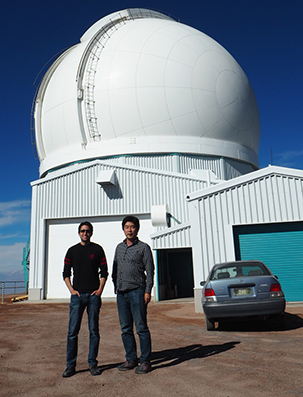 David Principe and Kenji Hamaguchi
David Principe and Kenji HamaguchiAs our guest blogger, we welcome Kenji Hamaguchi of the Center for Research and Exploration in Space Science & Technology and NASA’s Goddard Space Flight Center in Greenbelt, MD. He is part of the team that made the discovery described in our latest press release on an X-ray flare from a very young Sun-like star.
The observatory dome appeared over the hill. "Where is it standing?" I mumbled to myself. The Southern Astrophysical Research (SOAR) Telescope stands at the dead-end of a mountain ridge. The road just before the observatory has a bottleneck with steep slopes on both sides. The dome looked as if it were standing on the head of a spear. The telescope is a part of the Cerro Tololo Inter-American Observatory in Chile, along with the Gemini South observatory, and the Vera Rubin Observatory (formerly the LSST), which is now under construction. David Principe and I had come to the SOAR observatory in mid-December 2017, to take images of the extremely young star ("protostar") HOPS 383 at near-infrared wavelengths.
The observation we were undertaking was conducted in coordination with an observation of the same protostar with NASA’s Chandra X-ray Observatory. The Chandra observation aimed to find any sign of high-energy (X-ray) radiation from this newborn star. In contrast, the SOAR observation was designed to monitor the current status of an outburst from HOPS 383 that peaked in 2008. We planned to deepen the understanding of its nature by combining these two observing techniques.
Submitted by chandra on Tue, 2020-06-09 09:07
This article appeared on NASA.gov, written by NASA public information officer Elizabeth Landeau, based on a press release from Keck Observatory.
Determined to find a needle in a cosmic haystack, a pair of astronomers time traveled through archives of old data from W. M. Keck Observatory on Mauankea in Hawaii and old X-ray data from NASA’s Chandra X-ray Observatory to unlock a mystery surrounding a bright, lensed, heavily obscured quasar.
This celestial object, which is an active galaxy emitting brilliant amounts of energy due to a black hole devouring material, is an exciting object in itself. Finding one that is gravitationally lensed, making it appear brighter and larger, is exceptionally exciting. While slightly over 200 lensed unobscured quasars are currently known, the number of lensed obscured quasars discovered is in the single digits. This is because the feeding black hole stirs up gas and dust, cloaking the quasar and making it difficult to detect in visible light surveys.
Submitted by chandra on Tue, 2020-06-02 08:43
By combining data from telescopes with supercomputer simulations and virtual reality (VR), a new visualization allows you to experience 500 years of cosmic evolution around the supermassive black hole at the center of the Milky Way.
This visualization, called "Galactic Center VR", is the latest in a series from astrophysicists, and is based on data from NASA's Chandra X-ray Observatory and other telescopes. This new installment features their NASA supercomputer simulations of material streaming toward the Milky Way's four-million-solar-mass black hole known as Sagittarius A* (Sgr A*). The visualization has been loaded into a VR environment as a novel method of exploring these simulations, and is available for free at both the Steam and Viveport VR stores.
Submitted by chandra on Thu, 2020-05-28 18:55
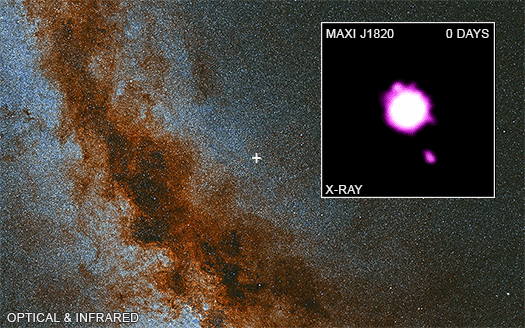 MAXI J1820+070
MAXI J1820+070
Credit: X-ray: NASA/CXC/Université de Paris/M. Espinasse et al.; Optical/IR:PanSTARRSAstronomers have caught a black hole hurling hot material into space at close to the speed of light. This flare-up was captured in a new movie from NASA's Chandra X-ray Observatory.
The black hole and its companion star make up a system called MAXI J1820+070, located in our Galaxy about 10,000 light years from Earth. The black hole in MAXI J1820+070 has a mass about eight times that of the Sun, identifying it as a so-called stellar-mass black hole, formed by the destruction of a massive star. (This is in contrast to supermassive black holes that contain millions or billions of times the Sun's mass.)
Submitted by chandra on Fri, 2020-05-08 10:24
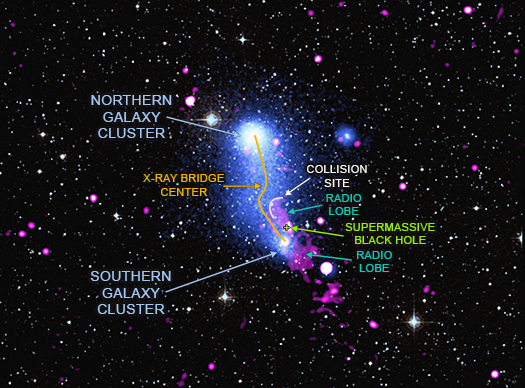 Abell 2384
Abell 2384
Credit: X-ray: NASA/CXC/SAO/V.Parekh, et al. & ESA/XMM-Newton; Radio: NCRA/GMRTSeveral hundred million years ago, two galaxy clusters collided and then passed through each other. This mighty event released a flood of hot gas from each galaxy cluster that formed an unusual bridge between the two objects. This bridge is now being pummeled by particles driven away from a supermassive black hole.
Galaxy clusters are the largest objects in the universe held together by gravity. They contain hundreds or thousands of galaxies, vast amounts of multi-million-degree gas that glow in X-rays, and enormous reservoirs of unseen dark matter.
Submitted by chandra on Wed, 2020-04-22 17:07
 Andrew King
Andrew KingWe are pleased to welcome Andrew King from the University of Leicester in the United Kingdom as a guest blogger. Andrew is the author of a paper that is the subject of our latest press release. He graduated in Mathematics from the University of Cambridge (UK), and then researched there for his PhD in General Relativity. After postdoctoral positions in London and Hamburg, he moved to the University of Leicester, where he is now Professor of Theoretical Astrophysics. He is a long-term visitor at the Anton Pannekoek Astronomical Institute in the University of Amsterdam, and Visiting Professor at Leiden Observatory. His interests include ultraluminous X-ray sources, accretion and feedback involving supermassive black holes, and how this affects their host galaxies.
A few months ago, Giovanni Miniutti from ESA's Center for Astrobiology in Spain, and collaborators observed that X-ray emission from the low-mass nucleus (that is, a relatively small black hole at its center) of the galaxy GSN 069 brightened by factors of about 100 roughly every 9 hours, staying bright for about an hour each time before returning to the faint state. From the X-ray spectrum — the intensity of X-rays at different wavelengths — they deduced that the X-rays came from an accretion disk around the central black hole of the galaxy, which has the rather low mass of about 400,000 times that of the Sun. I was intrigued by these observations: the eruptions implied that a lot of mass was being fed into the accretion disc every 9 hours, and the reasonably stable period suggested there was something in a very close orbit around the black hole.
Submitted by chandra on Mon, 2020-04-13 09:34
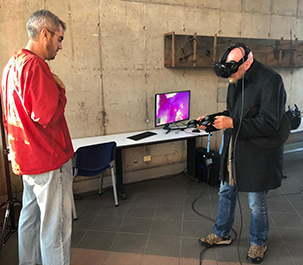 Nobel Laureate Prof. Kip Thorne
Nobel Laureate Prof. Kip Thorne
exploring the the VR app, assisted
by Dr. Christopher Russell.
"Galactic Center VR" is an astronomy outreach app available now from the Steam and Viveport virtual reality (VR) stores. What is in this VR experience, and how did it come about? Dr. Christopher Russell, Director of the VR Lab at the Instituto de Astrofísica, Pontificia Universidad Católica de Chile (PUC), tells us in this blog post.
"Galactic Center VR" (GCVR) transports you 26,000 light years away to the center of our Milky Way. This fully immersive VR experience lets you explore our NASA supercomputer simulations of the central three light years around Sagittarius A* (Sgr A*), our galaxy's supermassive black hole. While the black hole is the region's dominant feature, the visual appeal comes from the complex structure of colliding winds from 25 massive stars, much of which is heated by shocks — akin to sonic booms from supersonic aircraft — to be aglow in X-rays and therefore studied with NASA's Chandra X-ray Observatory.
Submitted by chandra on Tue, 2020-04-07 16:26
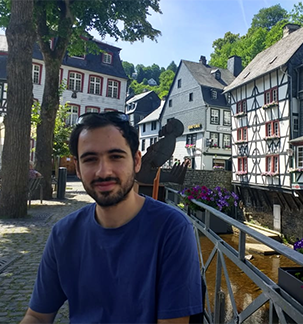 Konstantinos (Kostas) Migkas
Konstantinos (Kostas) MigkasWe are pleased to welcome Konstantinos (Kostas) Migkas as a guest blogger. Kostas is a doctoral researcher in the Argelander Institute of Astronomy of the University of Bonn, Germany, and led the study that is the subject of our latest press release. He received his Bachelor's degree in Physics from the Aristotle University of Thessaloniki, Greece, in 2015. Then he moved to Germany and Bonn to obtain his Master's degree in Astrophysics in 2017. He started his PhD by the end of the same year in the group of Prof. Thomas Reiprich working on cosmology with galaxy clusters, exploiting a novel method they designed to study one of the key principles of cosmology.
Our understanding of the Universe has significantly improved in the last 25 years. The accelerating expansion of the Universe, the detailed observation of the leftover relic radiation from the Big Bang (cosmic microwave background, or CMB), the in-depth study of the Universe's structure and the unfolding of the cosmos in the whole range of the electromagnetic spectrum are some of the accomplishments that led astronomers to precisely constrain the so-called cosmological parameters. The latter describe the properties of the Universe in various ways. These include: how much "normal" and "dark" matter the Universe contains, the nature of the mysterious dark energy, and maybe most importantly, the expansion rate of the Universe.
To push cosmological knowledge forward, scientists have to inevitably make some assumptions about the Universe. One of the most fundamental ones is that it acts the same way towards every direction of the sky. Practically, this means that the behavior of the astrophysical objects, for instance galaxies or clusters of galaxies, should look the same no matter where we look. It also means that the cosmological parameters, including the expansion rate of the Universe, must be the same independent of the direction. We call this property "isotropy".
Pages